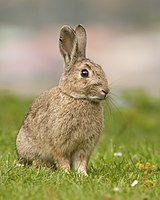
Rabbit
Rabbits, also known as bunnies or bunny rabbits, are small mammals in the family Leporidae (which also includes the hares), which is in the order Lagomorpha (which also includes the pikas). Oryctolagus cuniculus is the European rabbit, including its descendants, the world's 305 breeds[1] of domestic rabbit. Sylvilagus includes 13 wild rabbit species, among them the seven types of cottontail. The European rabbit, which has been introduced on every continent except Antarctica, is familiar throughout the world as a wild prey animal, a domesticated form of livestock and a pet. With its widespread effect on ecologies and cultures, in many areas of the world, the rabbit is a part of daily life – as food, clothing, a companion, and a source of artistic inspiration.
"Bunny" redirects here. For other uses, see Bunny (disambiguation) and Rabbit (disambiguation).Terminology and etymology
A male rabbit is called a buck; a female is called a doe. An older term for an adult rabbit used until the 18th century is coney (derived ultimately from the Latin cuniculus), while rabbit once referred only to the young animals.[2] Another term for a young rabbit is bunny, though this term is often applied informally (particularly by children) to rabbits generally, especially domestic ones. More recently, the term kit or kitten has been used to refer to a young rabbit.
A group of rabbits is known as a colony or nest (or, occasionally, a warren, though this more commonly refers to where the rabbits live).[3] A group of baby rabbits produced from a single mating is referred to as a litter[4] and a group of domestic rabbits living together is sometimes called a herd.[5]
The word rabbit itself derives from the Middle English rabet, a borrowing from the Walloon robète, which was a diminutive of the French or Middle Dutch robbe.[6]
Behaviors
Binkies, also more generally called zoomies,[79] in rabbits are characterized by a sudden kick with their hind legs, shaking their heads sideways (usually mid-air), and running around rapidly. Another term is half-binky, which is characterized by a shorter span and a sharp flick of the head. Both types of binkies indicate happiness or excitement. All of which typically only last for around a second. A rabbit might do quick, rapid multiple binkies in one session. It is thought to be a practice run in case they need to escape from danger.[80] Binkies more commonly occur in domesticated rabbits living in a comfortable environment.[81]
Rabbits mostly use full-body actions, like flopping, to communicate emotion to other rabbits and humans. Rabbits flopping in front of other rabbits can be meant as a non-aggressive insult.[82][83] Rabbits commonly smell the ground first, then tilt their head to the side with a subtle jerky movement in order to lie down to its side, which exposes their belly. They may thump their hind feet on the ground to signal other rabbits that they're feeling threatened or that potential dangers are near their territory. Some domesticated rabbits might thump to get their owner's attention. Not all rabbits thump.[84]
Both sexes of rabbits often rub their chins on objects or people with their scent gland located under the chin. This is the rabbit's way of marking their territory or possessions for other rabbits to recognize by depositing scent gland secretions. It might also serve as a reminder for the rabbit to return and investigate the object later, helping them navigate in the dark and to help them in their recollection of where they have been. Rabbits who have bonded will respect each other's smell, which indicates a territorial border.[85][86]









